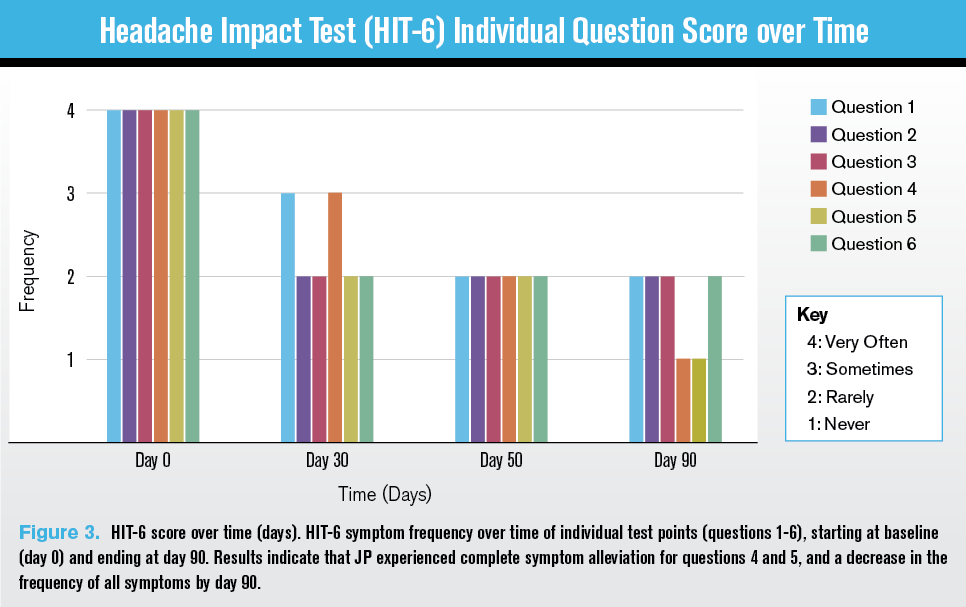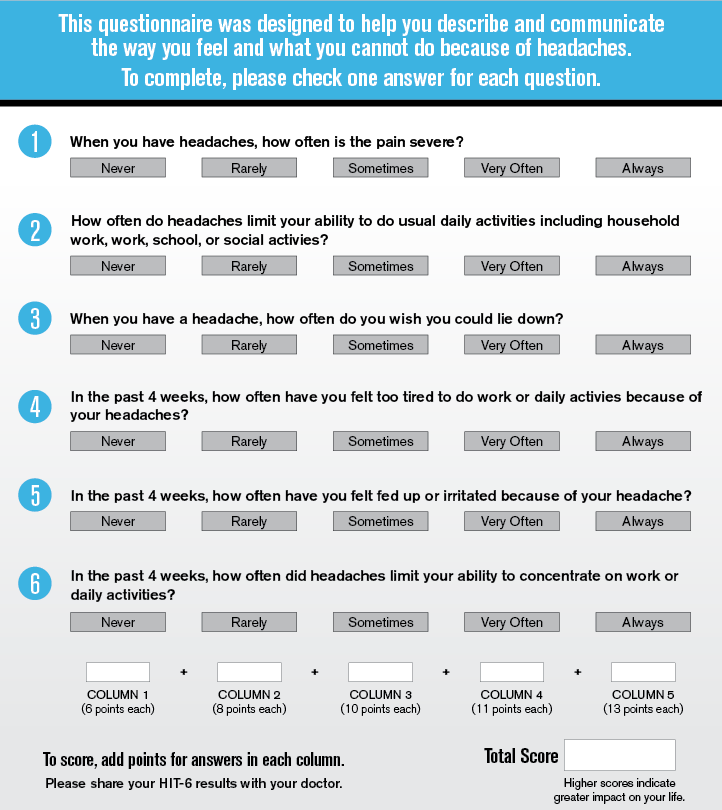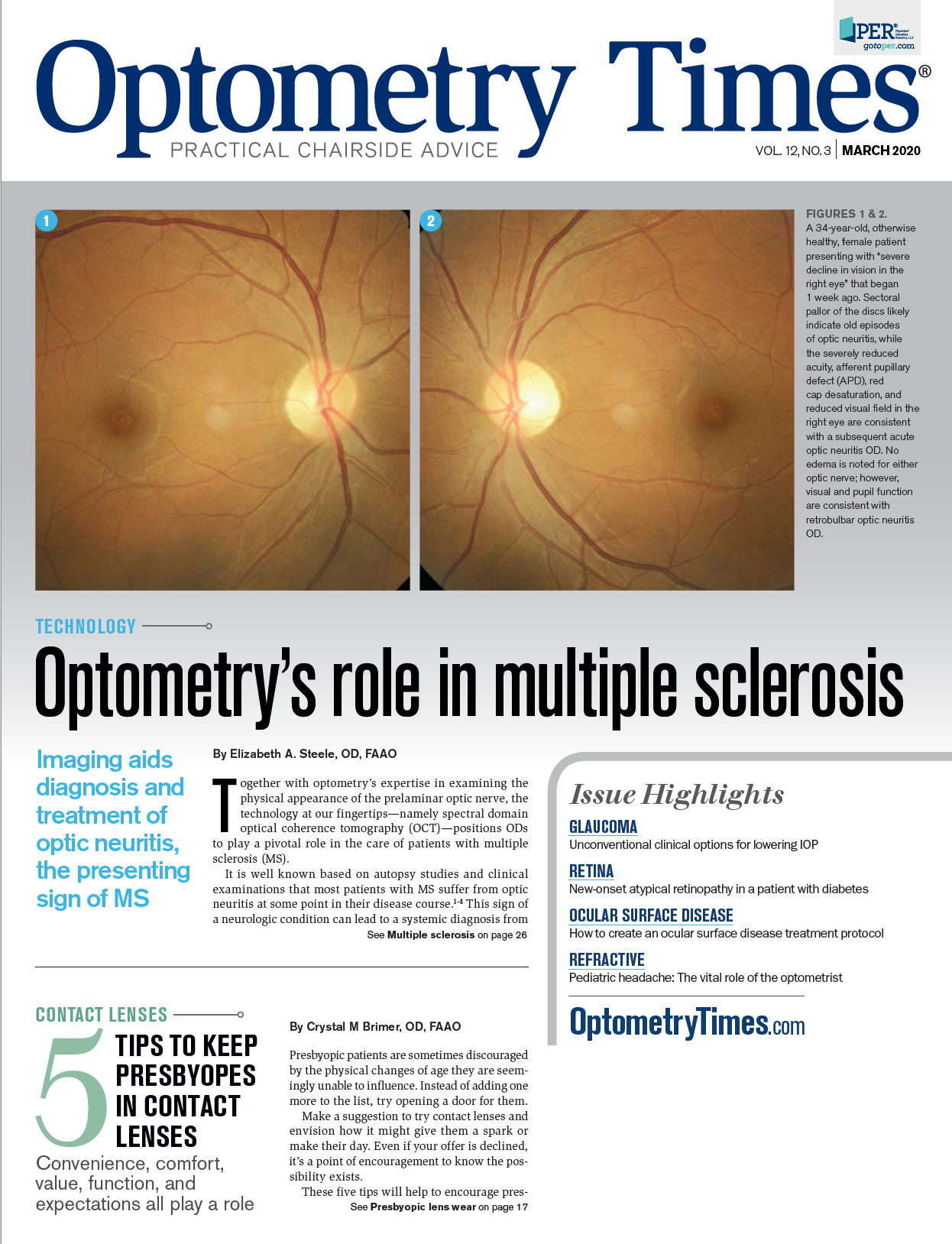The effect of contoured prism lenses on chronic headaches: a case study
Reduced symptoms and medication use after a 90-day follow-up

Yamam Almouradi, OD, is in group practice in Norwalk, CA

Figure 2: Headache Impact Test-6 Score over Time (days)

Figure 3: Headache Impact Test-6 Individual Question Score over Time

Figure 1: The six questions from the Headache Impact Test. To answer the questions, the patient chooses from never, rarely, sometimes, very often, always.

A case study of a patient who suffered from chronic daily headaches is presented in which use of contoured prism technology reduced the patient’s symptoms and use of medication. More studies are warranted to investigate these results further.
Ground-in prism and lens decentration are routinely utilized by optometrists and ophthalmologists to relieve symptoms of trigeminal dysphoria.1 This case study follows a symptomatic adult Caucasian male over 90 days to determine the effects of contoured prism technology on debilitating chronic daily headaches, using a validated Headache Impact Test (HIT-6).
Related: Look at the retina in a different way
Qualitative data analysis reveals that full-time wear of neurolenses, prescription spectacle lenses that add a contoured prism to bring the eyes into alignment, significantly improved patient HIT-6 score by 3.5 lifestyle changes.2 Notably, headaches that were frustrating and tiring enough to prevent activities of the patient’s daily living on a highly frequent basis were completely alleviated by Day 90.
Furthermore, there was subjective improvement of patient intake frequency of Advil (ibuprofen) and Excedrin (acetaminophen-aspirin-caffeine) as the patient was able to decrease intake from “daily” to “on very rare occasion.” Additionally, the case study patient was able to discontinue butalbital-acetaminophen-caffeine (50:325:40 mg) as well as amitriptyline previously prescribed by his neurologist.
Although a broader study is warranted, this case study suggests that adult patients suffering from chronic headaches significantly benefit from the addition of neurolenses, with contoured prism technology, to their medical regimen.
Related: Macular diseases: Emerging best practices for diagnosis, management and follow-up protocols
Background
Historically, vision care professionals have utilized ground-in prism as well as lens decentration in their prescribed refractive error correction to relieve patients of various symptoms of asthenopia.1 Neurologically, the use of prisms or lens decentration to achieve a prismatic effect is derived from the overstimulation of the fifth cranial nerve,3 which has been linked in previous studies to trigeminal dysphoria,4 among which chronic daily headaches (CDH)5 play a major role.
Related: New research highlights how data is processed to detect glaucomatous optic neuropathy
This case study investigates the efficacy of full-time contoured prism wear on symptom frequency and severity of chronic headaches in adult patients. The author hypothesizes that, if a positive correlation between full-time contoured prism wear and decreased chronic headache symptoms is achieved, then prescribing contoured prism lenses would provide an effective solution to improvement or complete resolution of chronic headaches not caused by systemic or ocular disease.
Consequently, the author hopes to provide an effective prescribing or referral tool for optometrists and other healthcare professionals, respectively, for patients with chronic headaches.
Related: How inflammation may play a role in retinal disease
Methods
One of the most symptomatic subjects in a non-published digital vision syndrome study was followed after the termination of the 30-day trial, for a total of 90 days, in order to determine the efficacy of full-time contoured prism use on chronic headache severity.
JP is a 49-year-old Caucasian male with a 20+-year history of severe chronic headaches that have interfered with his activities of daily living. He was prescribed several medications throughout these years in order to help him cope because the intensity and high frequency of his headaches were preventing him from work, academia, and social activities. JP was instructed to complete a HIT-6,2 which is a tool that measures the impact headaches have on a person’s ability to accomplish his or her activities of daily living (Figure 1).
Related: Know the latest on classifying and referring hypertension
HIT-6 was developed by an international team of headache experts from neurology and primary-care medicine; it is a reliable and valid tool for discriminating symptom impact on chronic headache patients.6
The scoring of HIT-6 assigns point values to symptom frequency, which increase proportionally to symptom severity. A change of six points in a patient’s score over time is indicative of one lifestyle change. HIT-6 was chosen instead of Migraine Disability Assessment (MIDAS) due to its higher accuracy in quantifying the intensity of pain rather than the frequency of headaches, the latter of which is the main focus of MIDAS.7
In order to gain insight on headache frequency improvement over the 90-day trial, JP was asked to keep a daily log of his headache frequency, intensity, and usage of analgesic medications. He was consistent with his daily log and compliant with the full-time wear regimen of his lenses during the 90-day trial.
Related: Telephone triage: Recognize potential visual disturbance emergencies
Results
During baseline testing, JP’s HIT-6 score showed that he was experiencing disabling pain and symptoms that were interfering with his activities of daily living. His HIT-6 score improved steadily over the 90-day trial period, resulting in three-and-a-half lifestyle changes (Figure 2).
Although all six specific headache symptoms in the HIT-6 questionnaire showed great improvement over time, Questions 4 and 5 displayed complete symptom alleviation on Day 90. Question 4 assessed patient headache severity leading to overall fatigue that prevented daily activities, and Question 5 inquired about patient frustration or irritability secondary to headaches (Figure 3).
Related: How to recognize and manage digital eye strain
By Day 90, JP was successfully able to discontinue his two prescribed pain medications. Additionally, he was able to notably decrease his intake of Advil and Excedrin from a daily frequency to rare occasions.
Conclusion
As with any case study, specific details might vary among patients, which in turn makes it difficult to generalize data points.
Contoured prism technology offers a customized prism that progresses down the lens to achieve increasing degrees of convergence relief as the patient shifts his or her focus from distance to a near target. This case study reveals that full-time contour prism could in fact be used as a successful tool to alleviate debilitating headaches and notably decrease, if not abate, the need for daily pain medication in adults suffering from chronic headaches.
The author recommends future studies to investigate contoured prism efficacy on chronic headaches and other trigeminal dysphoria symptoms experienced by younger adult patients as well as children. Future larger-scale studies are also warranted on adults with chronic headaches in order to achieve repeatable results.
Read more: Common systemic conditions associated with dry eye disease
References:
1. Green, AS. The Value of Prisms in Eye Strain. Cal State J Med. 1912 Nov;10(11):453-5.1.
2. Kosinski M, Bayliss MS, Bjorner JB, Ware JE Jr, Garber WH, Batenhorst A, Cady R, Dahlöf CG, Dowson A, Tepper S. A six-item short-form survey for measuring headache impact: the HIT-6. Qual Life Res. 2003 Dec;12(8):963-74.
3. Leigh RJ, Zee DS. The ocular motor periphery. In: Neurology of Eye Movements. 5th ed. Oxford University Press, 2015.
4. Kent C. Binocular Vision: Keeping It Together. Rev Ophthalmology. Available at: www.reviewofophthalmology.com/article/binocular-vision-keeping-it-together. Accessed 2/24/20.
5. Ahmed F, Parthasarathy R, Khalil M. Chronic daily headaches. Ann Indian Acad Neurol. 2012 Aug;15(Suppl 1):S40-50.
6. Yang M, Rendas-Baum R, Varon SF, Kosinski M. Validation of the Headache Impact Test (HIT-6) across episodic and chronic migraine. Cephalalgia. 2011 Feb;31(3):357-67.
7. Sauro KM, Rose MS, Becker WJ, Christie SN, Giammarco R, Mackie GF, Eloff AG, Gawel MJ. HIT-6 and MIDAS as measures of headache disability in a headache referral population. Headache. 2010 Mar;50(3):383-95.

Newsletter
Want more insights like this? Subscribe to Optometry Times and get clinical pearls and practice tips delivered straight to your inbox.